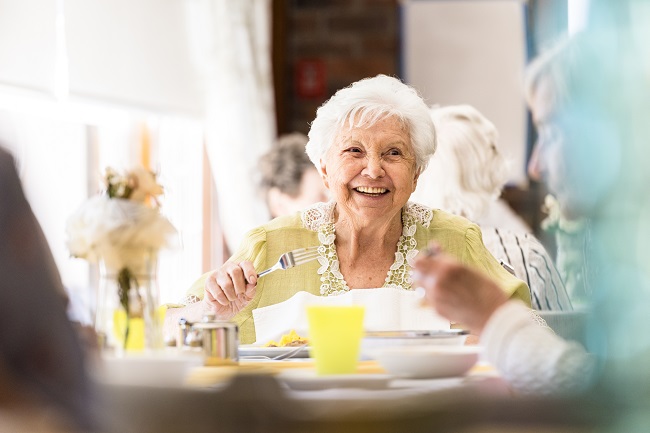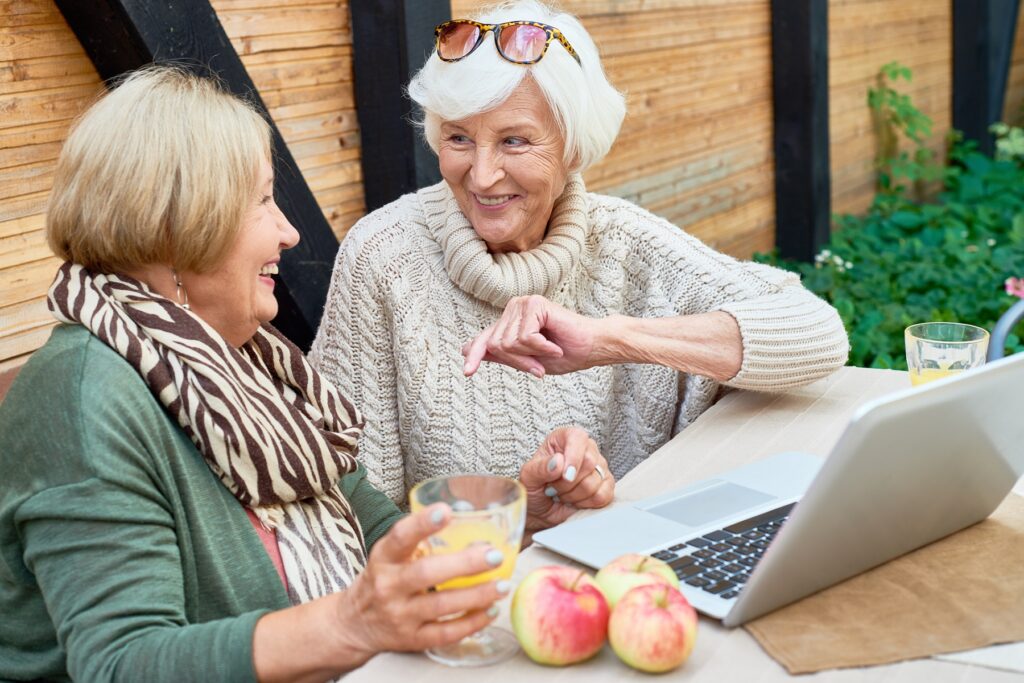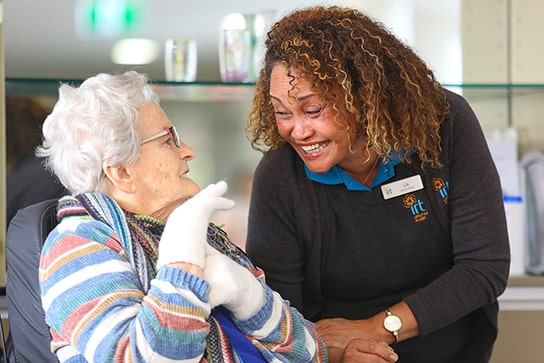A guide to healthy eating for older adults
Learn about how you can eat well as you get older and why it matters.

Healthy eating used to be as simple as “eat your greens” and “an apple a day keeps the doctor away”. If only it were that simple. These days, we know that what we eat can have a significant impact on all aspects of our wellbeing. And, as we get older, the food that fuels our bodies becomes increasingly important. Read on to learn more about a healthy eating plan to help you feel healthier and happier in later life.
What is healthy eating?
Healthy eating doesn’t mean you need to skip dessert or wave away the bread basket to maintain a healthy weight.
Accredited practising dietitian and spokesperson for the Dietitians Association of Australia Joel Feren has been working in the aged care space for seven years and says there are numerous misconceptions around what is actually healthy for older people.
“Foods that are considered to be less healthy for younger people may be appropriate for older people as they need extra calories to prevent muscle wastage. Foods such as double thick custard, ice creams, milkshakes and cakes with extra cream are encouraged for those who are nutritionally compromised.”
It’s important to remember that healthy eating is not the same for everyone, and your diet and foods and drinks should be tailored to fit your personal needs. Ensure that you’re eating a variety of foods to get the nutrients, vitamins and minerals that your body needs.
Feren emphasises the need to “take a holistic and well-rounded approach to nutrition and getting the five core food groups every day”.
The Australian Guide to Healthy Eating spells out those five food groups:
- Meat, fish and other seafood, poultry, eggs, nuts and legumes
- Milk, yoghurt, cheese, custard an ice cream
- Bread, cereals, rice, pasta and noodles
- Vegetables
- Fruits
What are the nutritional needs for older adults and why is it important?
As we get older we may have additional dietary needs compared to when we were younger. It’s important to target certain foods to eat that will make us feel healthier and more energetic.
Dietitian Corinne Cox has over 20 years’ experience under her belt and consults with IRT Catering to oversee the meals provided to aged care centres. She emphasises the importance of paying specific attention to older peoples’ nutritional requirements including energy, protein, fibre, zinc and calcium.
Nutritional needs won’t be exactly the same for every individual, but here are some important nutrients that you should consider.
Calcium
As we get older, our bone density decreases and we’re more vulnerable to falling and fractures. The Dietitians Association of Australia says that calcium needs to increase in later years, for women aged 50 and over and men aged 70 and over. Calcium is necessary to support bone health and to prevent the risk of fractures and osteoporosis.
Feeling thirsty? Milk is a great source of calcium. If milk isn’t your thing, try foods like yoghurt, cheese, canned salmon, sardines, spinach, kale, bok choy, sesame seeds and almonds. You’re one sip of milk away from beating your push-up personal best.
To increase your calcium intake, the Dietitians Association of Australia suggests snacking on cheese and wholegrain crackers, adding ricotta or feta cheese to salads, or grating some cheese into your omelettes, pasta and vegetable dishes.
Vitamin D
Vitamin D is needed to help absorb calcium in the body and also helps to prevent many serious health problems. Small amounts of Vitamin D can be found in fatty fish, live eggs and Vitamin D fortified margarine, so aim to include them in your diet.
The best source of Vitamin D does come from being outside in the sun, but be sure to limit this and be aware of when UV rays are strongest during the day. Next time you’re wanting to get a bit more Vitamin D, try having a cup of tea or a snack outside, doing some easy gardening or going for a walk around the neighbourhood.

Omega-3 oils
As we age we may be more vulnerable to heart disease, dementia, macular degeneration and rheumatoid arthritis symptoms. How do we combat this?
Omega-3 oils are a great preventative nutrient. It can be found in oily fish with soft edible bones such as salmon, sardines, mackerel and tuna, as well as plant based source such as canola oil, flaxseed/linseed oil, chia seeds walnuts and soybeans.
Protein
When we hit about 50 years of age, we begin to gradually lose skeletal muscle. It’s a normal part of ageing, but increasing our protein intake effectively can help maintain muscle structure and strength.
“In general older people don’t actually need as much energy (or calories) as younger people but they have higher protein needs which is often overlooked. They need to have high protein meals three times a day,” Corrine Cox says.
The best sources include lean meats and poultry, fish, eggs and milk products. The next best include wholegrains, beans/legumes and nuts and seeds.
Joel Feren makes an important point that our body gets rid of any extra protein we don’t need or stores it as fat, so there’s no need to go overboard with adding in extra protein foods.
Fibre
An inevitable part of ageing is the slowdown of our digestive system. This means maintaining a high-fibre diet is extremely important in lowering blood cholesterol, protecting against weight gain, and reducing the risk of cardiovascular disease and type 2 diabetes. Increasing your fibre intake may not sound riveting, but you’ll thank yourself for it.
Try to ditch the white and switch to wholemeal or multigrain cereals and breads and brown rice. Fruits and vegetables are your friends, so for dinners, add dried peas and an extra vegetable to your meals. And if you can squeeze in some beans and lentils, even better. Feeling like a snack? Try to go for some dried or fresh fruit, nuts or wholemeal crackers. But remember to be careful about eating tough foods if you have missing teeth, sore gums or dentures.

What should older adults have on their plate?
Corrine Cox says that older people often have smaller appetites, but it is important they still meet their nutritional needs by eating a variety of nutritious foods and including snacks in between as well.
On the same point, Joel Feren says older people should always include something nourishing on their plate such as meat, fish, eggs, wholegrains, or chickpeas.
Based on material provided by the National Health and Medical Research Council (NHMRC), “declining energy expenditure with age must be balanced by adjusting energy intake to maintain body weight within the healthy range”.
NHMRC has also found evidence that is often better for people aged 65 and over to “carry a little extra weight and have a slightly higher body mass index”. Feren says that generally people aged 65 and over should prevent any unnecessary weight loss. As such, diets that restrict nutritional intake would not be beneficial as they would reduce muscle, not fat.
According to the Dietitians Association of Australia, 40% of Australians over 65 years are either malnourished or at high risk of malnutrition. So, it is extremely important to stay nourished and avoid being too restrictive in what you eat.
NHMRC’s Australian Dietary Guidelines suggest the following daily recommendations for older adults:
Grain (cereal) foods
- Men aged 51-70: 6 serves
- Men aged 70 and over: 4.5 serves
- Women aged 51-70: 4 serves
- Women aged 70 and over: 3 serves
1 serve is equivalent to 1 slice of bread, half a cup cooked porridge, 1 crumpet, 1 small English muffin or scone, or half a cup cooked rice, pasta, noodles, barley.
Vegetables
- Men aged 51-70: 5.5 serves
- Men aged 70 and over: 5 serves
- Women aged 51-70: 5 serves
- Women aged 70 and over: 5 serves
1 serve is equivalent to a half cup cooked green or orange vegetables, half cup cooked, dried or canned beans, peas or lentils, 1 cup green leafy or raw salad vegetables, half a medium potato or other starchy vegetables.
Fruit
- Men aged 51-70: 2 serves
- Men aged 70 and over: 2 serves
- Women aged 51-70: 2 serves
- Women aged 70 and over: 2 serves
1 serve is equivalent to 1 medium apple, banana, orange or pear, 2 small apricots, kiwi fruits or plums, or 1 cup diced or canned fruit (no added sugar).
Lean meats and poultry, fish, eggs, tofu, nuts and seeds, and legumes and beans
- Men aged 51-70: 2.5 serves
- Men aged 70 and over: 2.5 serves
- Women aged 51-70: 2 serves
- Women aged 70 and over: 2 serves
1 serve is equivalent to 30g nuts, seeds, peanut or almond butter, 2 large eggs, 80g cooked lean poultry such as chicken or turkey, 65g cooked lean meats such as beef, lamb, veal, pork, goat or kangaroo, or 1 small can of fish.
Milk, yoghurt, cheese and/or alternatives
- Men aged 51-70: 3.5 serves
- Men aged 70 and over: 3.5 serves
- Women aged 51-70: 4 serves
- Women aged 70 and over: 4 serves
1 serve is equivalent to 1 cup fresh, UT long life, reconstituted powdered milk or buttermilk, ¾ cup of yoghurt, 2 slices of hard cheese such as cheddar, or half cup of ricotta cheese.

Top tip for healthy eating: stock your cupboard
Buying fresh groceries every day isn’t always realistic as we get older and less mobile. Stocking up on foods that will last a long time can make things easier and leaves more time to do the things that matter.
Buy long-life nutrient-rich foods including:
- Canned fruit and canned long life fruit juice
- Canned vegetables e.g. corn, beetroot, tomatoes, mushrooms
- Baked beans and bean mixes
- Rice, spaghetti, pasta, flour, rolled oats and breakfast cereals
- Canned soups
- Canned meat e.g. tuna, sardines, salmon.
Don’t forget: aim to buy products without added salt or sugar!
Healthy eating is only one part of the bigger picture
We must eat well to age well. But healthy eating is only part of the bigger picture of our wellbeing. The best recipe for a well-rounded healthy lifestyle means complementing healthy eating with regular exercise and a healthy mind.
If you’re over 65 and don’t have any health conditions that limit your ability to move, daily exercise or light activity has incredible benefits. Physical activity helps to make you feel better emotionally, improve your brain’s memory, reasoning abilities and reaction times. It also importantly helps to reduce manage pain, maintain and increase joint movement and reduces the risk of heart disease, stroke and some cancers. Try incorporating physical activity in your daily life, such as walking fast, doing water aerobics, riding a bike on level ground or pushing a lawn mower.
Keep a healthy mind too. Try things like meditation, relaxation, getting a good night’s sleep, doing crosswords or other mental games or reading books.
Feeling hungry after all that reading? You know what to do! Just be sure to talk to your doctor before making any significant dietary changes.

Need a helping hand at home?
Find out more about IRT Home Care and how we can assist you or your loved one to keep living independently at home. IRT has been providing home care services for more than 30 years, offering support to seniors in NSW, Qld and the ACT.
Find out moreYou may also like
Choosing an Aged Care Centre: What to consider
Moving from your home into a residential aged care centre can be a rewarding experience for you or your loved one.
Your guide to moving into a retirement village
When the decision to move into a retirement village has been made, the thought of packing up your old home and moving in to your…


